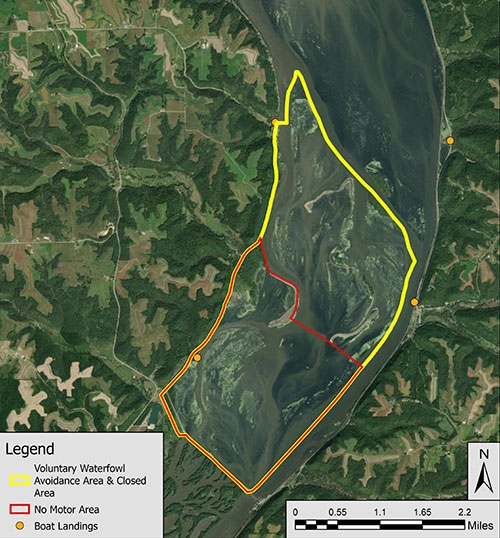You are here
Home ›U.S. Fish and Wildlife Service revises upcoming no motor closure of Harpers Slough

Revised Harpers Slough closure ... The Upper Mississippi River National Wildlife and Fish Refuge’s previous version of the Refuge’s Closed Area Evaluation released in June of this year had the McGregor District Harpers Slough Closed Area(outlined in yellow above) identified as a No Motor Area during the period coinciding with the voluntary avoidance period (October 15 to the end of the Iowa duck hunting season). As a result of feedback from Iowa Department of Natural Resources (DNR) and others who identified impacts on commercial fishing operations, the No Motor Area designation has been modified and the Harpers Slough Closed Area will now be divided into a northern and southern area where the southern portion of the area (outlined in red above) will be limited to no motors during the voluntary avoidance area time period of October 15 until the end of the state duck season in mid-December, and the northern portion of the closed area will remain as a voluntary avoidance area. Image courtesy of the Upper Mississippi River National Wildlife and Fish Refuge.
Approval of the Upper Mississippi River National Wildlife and Fish Refuge’s (Refuge) Comprehensive Conservation Plan (CCP) in 2006 resulted in the Refuge’s current closed area system consisting of 20 closed areas on the river and three sanctuaries. All refuge closed areas and sanctuaries are characterized by a closure to all migratory bird hunting.
In addition to being closed to all migratory bird hunting, closed areas are closed to all hunting, trapping and camping during the period coinciding with duck hunting seasons within their respective states. Sanctuaries are closed to all public entry during the period of October 1 to the end of the duck hunting season.
Most of the refuge’s closed areas have an associated voluntary waterfowl avoidance area; boaters are asked to avoid these voluntary avoidance areas during the fall migration in order to reduce the disturbance to resting and feeding waterfowl. When boats pass too close to waterfowl and cause them to take flight off the water, it can be really draining on their energy reserves at a time when they have little energy to spare.
The CCP also directed refuge management to monitor the voluntary waterfowl avoidance areas to determine if the strategy was sufficient in preventing disturbance to waterfowl. If disturbances were occurring over the threshold limit within an avoidance area, additional strategies would be considered to ensure reduced disturbance to waterfowl.
In a previous version of the Refuge’s Closed Area Evaluation released in June of this year, the administration of the McGregor District Harpers Slough Closed Area was identified as one of the areas where the disturbance threshold was exceeded. Due to the level of disturbance, it was identified as a No Motor Area during the period coinciding with the voluntary avoidance period (October 15 to the end of the Iowa duck hunting season).
Since the release of that report, Iowa Department of Natural Resources (DNR) and others identified impacts on commercial fishing operations and have requested a phased approach to addressing the disturbance in this area. As a result, the No Motor Area designation has been modified.
The Harpers Slough Closed Area (basically, between Heytman’s Landing south to Lock & Dam No. 9 - see map at right) will now be divided into a northern and southern area where the southern portion of the area will be limited to no motors during the voluntary avoidance area time period of October 15 until the end of the state duck season, and the northern portion of the closed area will remain as a voluntary avoidance area.
The area will be posted along the boundaries to identify the restrictions. Boaters are highly encouraged to avoid the entire closed area in order to allow migrating waterfowl a place to rest and feed undisturbed. The Refuge and its State partner, Iowa DNR, will continue to evaluate the need for additional changes through monitoring disturbance in the area. If disturbance cannot be mitigated through this phased approach, further restrictions in this area will be required.
For more information about these changes and for the full report please visit the refuge website https://www.fws.gov/refuge/upper_mississippi_river/.
In addition to being the most visited refuge in the country, the “Upper Miss” Refuge has the added complexity of a major navigation system, including 11 locks and dams, within its boundary. It is also a world-class fish and wildlife area which harbors 306 species of birds; 119 species of fish; more than 200 active bald eagle nests; thousands of heron and egret nests; spectacular concentrations of canvasback ducks, tundra swans and white pelicans; and several threatened or endangered species.
The mission of the U.S. Fish and Wildlife Service is working with others to conserve, protect and enhance fish, wildlife, plants and their habitats for the continuing benefit of the American people. For more information about the Service, visit www.fws.gov.

